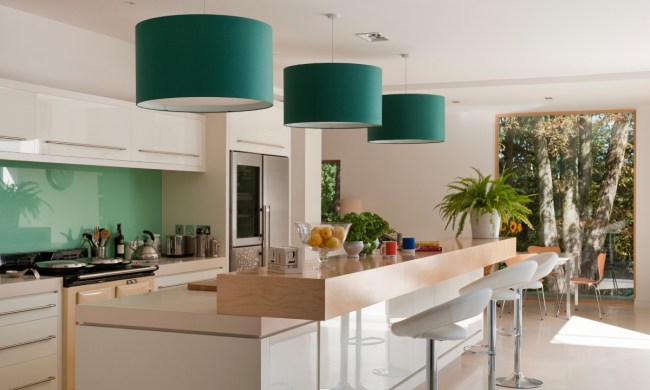Zellige tile may not be a new fad in home decor, but it has certainly become a more prevalent feature in interior kitchen designs. With a focus on shape, texture, and color, this exquisite tile brings an organic and natural feel into the home. While this handmade Moroccan material has enamored people for years, it’s slowly becoming a must-have feature as people move towards more biophilic home designs.
But what is Zellige tile? And why is it such a gorgeous statement in so many kitchens? Here, we’ll discuss everything you need to know about this elegant kitchen feature.
What is Zellige tile?
These zellige tiles from @riadtile show exactly why zellige tiles are so popular. Zellige tile, also known as Zellij, is a handmade Moroccan tile design made from a mixture of clay and water, then kiln-fired over olive pits. Once fired, an enamel glaze is applied to each tile to create a stunning, glass-like ceramic effect. No two Zellige tiles are the same since each piece is individually sculpted by hand. Because of this, Zellige tile has a luxe and organic look.
The hills and valleys on each individual tile create a rugged yet natural effect. And once placed in the kitchen, shadows on the tile give it an incredible and unmatched illusion of shades and colors that many homeowners are rightfully obsessed over. This Moroccan tile has been around since the early 10th century, inspired by Roman and Byzantine mosaic tiles. As an ancestor of the classic subway tile, Zellige is a timeless addition to the household and great for anyone craving something unique to add character to their home.
Where can you purchase authentic Zellige tiles?
For the most authentic Zellige tiles, heading straight to the source is the best way to ensure you get a high-quality product. Moroccan tile businesses or other specialty stores selling these handmade tiles often have a vast selection of colors, shapes, and sizes to choose from. Due to the nature of these handmade pieces, as well as the use of glaze, no two tiles look the same. Ranging from vivid hues to pearlescent, there are several colors and varieties to choose from.
How much do Zellige tiles cost?
However, original Zellige tiles come at a steep cost. Some places sell a square foot of handmade tiles for fifty dollars. This is a broad difference compared to the affordable subway tile, which often sells for one dollar or less per square foot. Still, several companies ship these beautiful handmade tiles straight from Morocco. Just be sure to check for imperfections and discuss the source of these pieces!
Though, if you’re obsessed with this look and want an affordable way to bring it into your space, a manufactured Zellige tile alternative could be a great solution. It may not look as imperfect and organic as the handmade method, but it should still provide a wonderful shaded and rugged effect in your space.
How can you incorporate this beautiful feature in your kitchen design?
If the organic and unique appearance of Zellige tile appeals to you, then you might be wondering how to incorporate it into your design. There are so many ways to design with this feature, from vintage to modern, as the above design from @mdesignsinteriordecorating proves. Here are our best tips.
Pair them alongside organic materials
Since Zellige tile is known for its natural look, it can help to enhance the charm of these handmade materials by pairing them alongside other organic pieces. Raw woods, stone pieces, wicker bowls, or other handmade pottery items can help create a stunning and authentic look in your space. A Zellige tile backsplash can be a great addition behind a classic wood-burning stone. Or alongside a natural wood countertop.
Use them as a statement in your space
The best way to show off your Zellige tile is to create a statement in your space. Placing Zellige tile as an accent wall in your kitchen or allowing it to be the pop of color in a more modern design are great ways to show off your unique kitchen feature. Additionally, these tiles from Morocco look gorgeous on a center island, especially when paired with a wood or stone countertop.
Opt for white cabinetry for a more modern look
One of the classic ways Moroccan Zellige tiles are being incorporated into kitchen design is by using them in modern-styled spaces. White cabinets, simple cream or white-toned countertops, classic oak wood flooring, and a minimal aesthetic can create the perfect backdrop for Zellige tile.
This simple, modern style allows the colors, shades, and textures in handmade Zellige tile to pop. Smooth and sleek surfaces offer a fantastic juxtaposition to the organic feel of this handmade tile, creating a striking yet stunning look in the kitchen.
Try out brass details on nearby fixtures
Another great way to style Zellige tile is by using brass and copper in your design. Brass or copper fixtures like the sink faucet, cabinet knobs or handles, metallic bowls or vases, and decorative frames in the space can create a luxe, gorgeous feel. This is also a great solution for anyone who doesn’t want to implement an entire kitchen remodel but favors the natural look of Zellige tile.
Handmade Moroccan tile is a great way to bring character and charm to your home. With so many hues to choose from, Zellige tile is a great way to enhance the look of your space without opting for the common subway tile. While it is a costly addition to any space, this luxe and elegant material is sure to offer a natural and authentic touch to your design. Just be sure to pair it with other organic or metallic accents to tie the space together.



